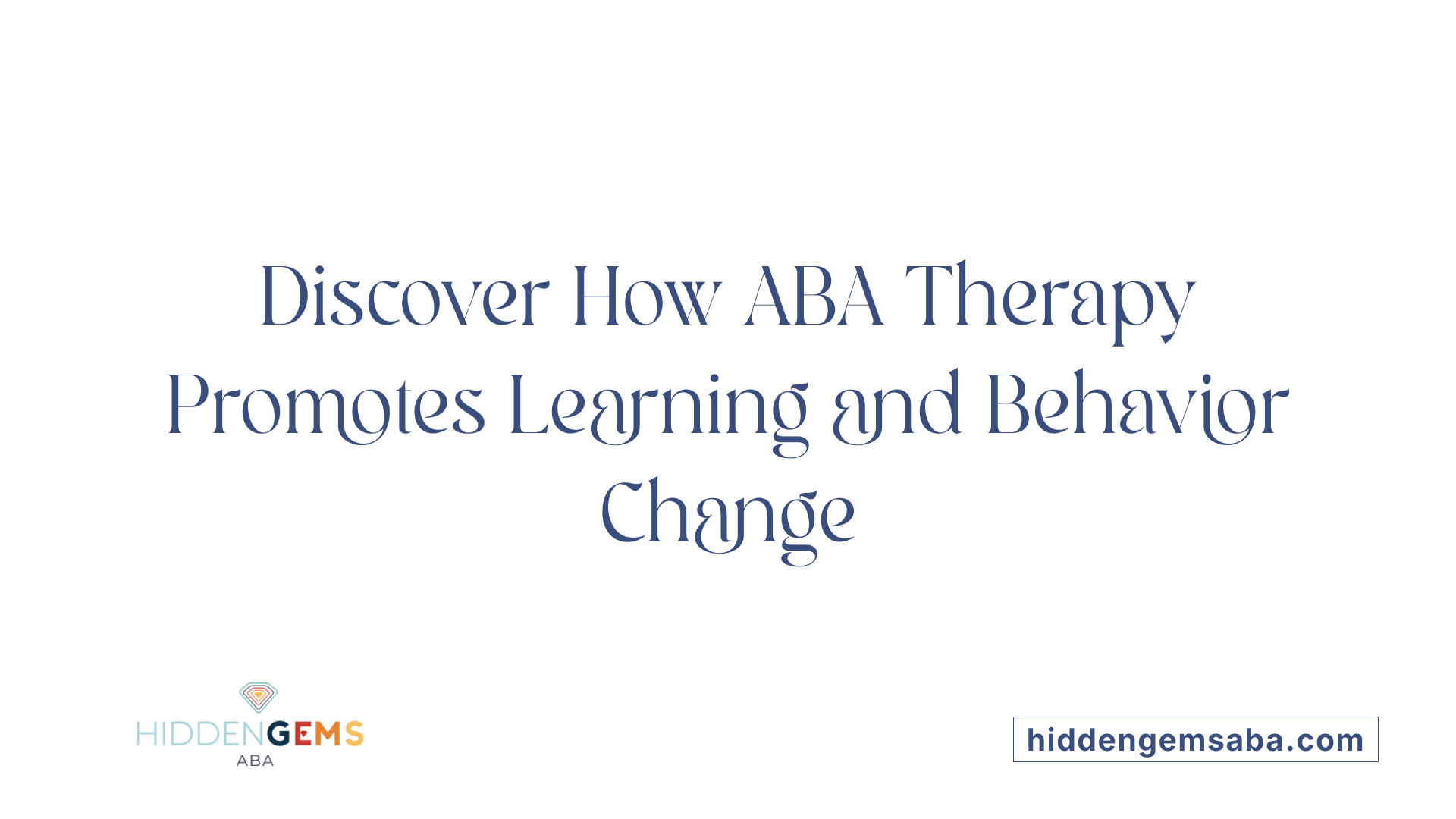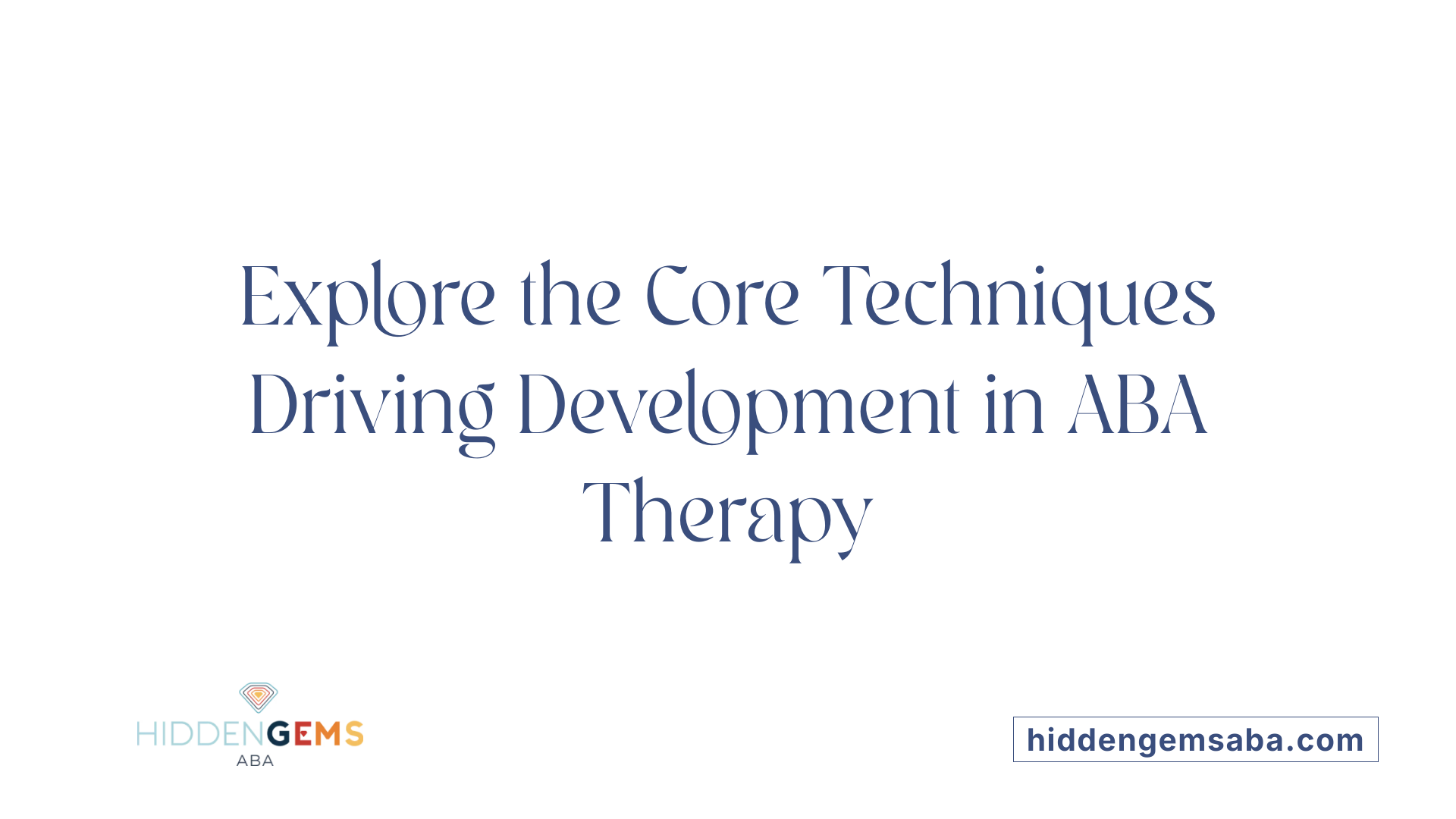Understanding the Impact of ABA Therapy on Children with Autism
ABA therapy, or Applied Behavior Analysis, stands as a proven, evidence-based intervention renowned for its effectiveness in enhancing the lives of children with autism. This comprehensive overview explores how ABA works, its core techniques, the measurable outcomes documented through research, and practical guidance for parents and caregivers to assess progress. With extensive scientific validation, ABA continues to be a cornerstone in autism support, offering hope for meaningful developmental advancement.
What is ABA Therapy and How Does It Work?

What is ABA therapy and how does it work?
Applied Behavior Analysis (ABA) therapy is a scientific approach designed to help individuals, particularly those with autism, develop helpful behaviors and reduce behaviors that may be harmful or unhelpful. It is based on understanding the connection between behaviors and environmental factors, using this knowledge to promote positive changes.
At its core, ABA analyzes how behaviors are influenced by antecedents—events that happen before a behavior—and consequences, which occur afterward. By doing so, therapists can identify triggers and reward desired behaviors to encourage their recurrence.
ABA employs a variety of techniques, including positive reinforcement—giving rewards to reinforce good behavior—which is tailored to each individual's preferences and needs. This personalized approach increases the likelihood that the individual will repeat positive behaviors.
A critical element of ABA therapy is developing a treatment plan customized to the individual’s specific goals. These goals often include improving communication skills, social interactions, self-care, play skills, motor development, and academic performance.
The therapy is delivered by trained therapists who work under the supervision of a qualified behavior analyst, known as a Board Certified Behavior Analyst (BCBA). This oversight ensures that strategies are evidence-based and appropriately adapted.
Each ABA session is data-driven, meaning that therapists collect detailed information on progress through assessments, reports, and visual tracking charts. This data allows therapists to monitor progress precisely and modify intervention strategies as needed.
Throughout therapy, progress is measured across multiple domains, including language, social skills, independence, and reduction of problem behaviors. Consistent review and collaboration with caregivers are crucial for tracking improvements and ensuring that gains are maintained.
Research supports ABA as an effective treatment, showing improvements in cognitive functioning, language development, daily living skills, and social engagement. Notably, long-term intensive ABA therapy—often involving 25-40 hours weekly over one to three years—has been linked to significant behavioral and developmental gains.
Overall, ABA therapy seeks to foster greater independence and social participation by helping individuals learn functional skills and alter behavior patterns to improve their quality of life, especially for children with autism and developmental disorders.
Core Techniques That Facilitate Development

How do the core techniques of ABA therapy facilitate development?
Applied Behavior Analysis (ABA) employs various scientifically proven techniques to help individuals develop new skills and reduce problematic behaviors. These core methods work together to create a structured learning environment tailored to each person’s needs.
One of the foundational techniques is positive reinforcement. This involves rewarding desired behaviors to encourage their future occurrence. Rewards—such as praise, tokens, or preferred activities—are carefully chosen to motivate each individual, making learning a positive experience. Reinforcement can be used across many settings—home, school, or community—and is a powerful way to shape behavior.
Another important method is the analysis of antecedents and consequences, often called ABCs. This involves identifying what happens before a behavior (antecedent), understanding the behavior itself, and noting what follows (consequence). By analyzing ABCs, therapists can determine the reasons behind behaviors, especially problematic ones, and adjust intervention strategies accordingly.
To teach complex skills, ABA utilizes prompting, fading, and chaining techniques. Prompting provides hints or assistance to encourage correct responses. Over time, prompts are gradually faded so the individual can perform skills independently. Chaining involves breaking down a task into smaller steps, then teaching each in sequence—this builds more complex behaviors from simple components.
Modeling, visualization, and video aids support learning by demonstrating behaviors or skills visually. For example, watching a video of someone performing a daily task helps a child imitate the behavior. These tools make abstract concepts concrete and are especially helpful in teaching social and daily living skills.
Consistent data collection and functional behavior assessments are critical components. Data tracking helps measure progress and effectiveness, while ABC analysis guides individualized intervention plans. Regular review of this data allows therapists to adapt strategies promptly, ensuring ongoing developmental support.
Together, these core techniques create a dynamic, personalized approach that promotes skill mastering, reduces harmful behaviors, and promotes generalization of skills across different environments. Each method reinforces the others, helping children and individuals with developmental challenges reach their full potential.
Expected Outcomes from ABA Therapy

What outcomes can be expected from ABA therapy?
Applied Behavior Analysis (ABA) therapy is well-regarded for its ability to foster meaningful progress in children with autism spectrum disorder (ASD). One of the primary goals is to enhance communication and social skills, which are often areas of difficulty for children with ASD. Many children show increased vocabulary, improved understanding of social cues, and greater engagement in social interactions.
Beyond communication, ABA therapy promotes significant behavioral improvements. It helps to decrease harmful or problem behaviors, such as aggression, self-injury, and other disruptive actions. On average, children undergoing ABA experience about a 90% reduction in severe behaviors by the time they graduate from programs.
Another important outcome involves daily living and adaptive skills. Children typically develop better self-care routines, motor skills, and independence in everyday activities. Regular assessment tools, like the Vineland-3, show that most children exhibit growth across multiple domains after 12 months of ABA services.
Long-term effects of ABA are especially encouraging. Many children demonstrate sustained improvements in emotional regulation, independence, and social functioning. For example, children who complete ABA programs often continue to exhibit gains in communication, self-care, and social skills years after therapy ends. These long-lasting changes significantly enhance their overall quality of life.
Family well-being and parental stress levels also benefit from ABA interventions. Research indicates that parents report high satisfaction with their child's progress, and many experience a reduction in stress. One study noted that families observed a 90% decrease in severe behaviors and reported normal levels of stress after about a year of therapy.
In summary, ABA therapy can be expected to deliver broad developmental benefits, including improved communication, reduced problem behavior, increased independence, and better emotional management. These outcomes contribute to greater lifelong functioning and improved family dynamics.
| Outcome Area | Typical Improvements | Supporting Data | Notes |
|---|---|---|---|
| Communication & Social Skills | Increased vocabulary, social engagement | 97% of ABA graduates meet communication goals | Lasting gains observed long-term |
| Behavior | Significant reduction in aggression, self-injury | 90% reduction in severe behaviors | Applies across settings |
| Daily Living & Adaptive Skills | Improved self-care, motor skills | Assessed via Vineland-3 | Especially evident after 12 months |
| Long-term Development | Sustained independence, emotional regulation | Continued improvements post-therapy | Reduced parental stress and high satisfaction |
| Family Well-being | Lower parental stress, high satisfaction | PSI-4 results; over 97% satisfaction | Positive family impact |
Overall, research and clinical data support ABA therapy as an effective means to promote comprehensive development and improve quality of life for children with ASD and their families.
Research Evidence Supporting ABA Effectiveness

What evidence supports the effectiveness of ABA therapy for children with autism?
Numerous scientific studies and meta-analyses confirm that Applied Behavior Analysis (ABA) is an effective intervention for children with autism. Research has consistently shown that ABA can lead to improvements across multiple developmental domains.
Studies demonstrate that children undergoing ABA therapy often experience small to moderate gains in social skills, language, and adaptive behaviors. When implemented early and with sufficient intensity—typically 25 to 40 hours per week over 1 to 3 years—these gains are more substantial. Controlled trials, including randomized controlled trials (RCTs), case-series studies, and single-case experimental designs, all support the positive impact of ABA.
Research data indicate notable reductions in problematic behaviors such as self-injury, aggression, and tantrums. At the same time, many children show enhanced communication abilities, better social interactions, increased independence, and improved daily living skills.
For instance, after 12 months of ABA services, assessments like the Vineland Adaptive Behavior Scales (Vineland-3) have demonstrated growth across all evaluated domains. Additionally, studies involving specific clinics report that over 97% of children achieve their individualized goals, such as feeding or behavioral targets. Caregivers also report high satisfaction, noting decreased stress and observable progress.
Major health agencies recognize ABA as a robust and effective treatment. The US Surgeon General and the American Psychological Association endorse ABA, citing its extensive scientific backing and consistent outcomes.
Outcome measures and their results
Research tracks improvement through various outcome measures, including:
- Cognitive Skills: An improvement, often quantified through IQ tests, with many children showing increased intellectual functioning.
- Language Development: Significant gains in vocabulary, expressive language, and communication skills.
- Social Skills: Better engagement with peers and adults, including shared attention and reciprocal interactions.
- Problem Behaviors: About 90% reduction in severe behaviors such as aggression and self-injury.
- Adaptive Behavior: Enhanced independence in daily activities.
These achievements are documented through skill assessments, progress reports, and visual charts tracking behaviors over time.
Success rates and statistical data
Research indicates that roughly 63% to 88% of study records report improvements in various developmental outcomes following ABA treatment. Fewer than 10% of studies have shown no measurable benefit. Specifically, approximately 97% of children receiving ABA at specialized clinics meet their occupational or behavioral goals.
A small percentage of studies—around 4%—used control or comparison groups to strengthen findings, showing that improvements are not solely due to natural development or placebo effects. Long-term follow-ups reveal sustained improvements, with reductions in severe behaviors by as much as 79% to 90%.
Limitations and need for further research
While the evidence for ABA's effectiveness is robust, some limitations exist. Many studies involve small sample sizes or single-case designs, which, while valuable, limit the ability to generalize findings broadly. Only about 6% of studies include control groups or compare ABA directly with other interventions.
Additionally, most research does not address longer-term outcomes like Quality of Life (QoL), suggesting a gap that future studies should fill. There is a need for large-scale, longitudinal, prospective research comparing ABA to alternative therapies and assessing sustained impacts on overall well-being.
Validation by health authorities
Major health organizations and authorities endorse ABA based on overwhelming scientific evidence. The US Surgeon General, the American Psychological Association, and other health bodies recognize ABA as a proven, effective intervention for autism spectrum disorder. This validation underscores the therapy’s standing in clinical practice and policy, assuring families of its benefits when applied correctly and consistently.
| Aspect | Findings | Additional Details |
|---|---|---|
| Improvements in Domains | Cognitive, language, social, adaptive behavior, problem behavior | Based on 770 studies; 63-88% report positive outcomes |
| Success Rates | 97% meet their individualized goals | Includes behavioral, feeding, social goals |
| Severe Behavior Reduction | Up to 90% reduction observed | Includes aggression, self-injury |
| Long-term Impact | Sustained improvements in communication and independence | Follow-up studies over multiple years |
| Limitations and Gaps | Small sample sizes, lack of QoL data | Calls for more comprehensive, long-term research |
| Endorsements from Authorities | Recognized by US Surgeon General, APA | Validates ABA as an evidence-based intervention |
Indicators of Progress and Measuring Success

What signs indicate that ABA therapy is helping a child?
Signs that ABA therapy is helping a child include observable improvements in communication skills, such as the child using words, gestures, or communication devices more effectively. Increased initiation of social interactions, like making eye contact, engaging with peers, or responding to social cues, are important indicators. A reduction in problematic behaviors, including tantrums, aggression, or self-injury, demonstrates progress. Additionally, greater independence in daily routines like dressing, grooming, and self-care shows success.
therapy also helps children generalize learned skills across different settings and situations, suggesting they can apply what they've learned in real life. Improvements in attention span, play skills, emotional regulation, and following instructions are positive signs. Regular assessments and ongoing data collection, coupled with parental involvement, further confirm that therapy is effective.
Long-term Benefits and Sustained Progress

What are the long-term effects of ABA therapy?
Applied Behavior Analysis (ABA) therapy is recognized for its ability to produce enduring improvements in individuals with autism and related developmental disorders. Extensive research and practical outcomes demonstrate that many of the behavioral changes and skill enhancements achieved through ABA are maintained over time, leading to a better quality of life for children and their families.
Research indicates that children who undergo intensive ABA programs often experience lasting reductions in severe behaviors such as aggression and self-injury. These improvements significantly contribute to their safety and social integration. For instance, in programs like those at The Behavior Centers, a 90% reduction in severe behaviors has been observed, with a corresponding increase in children’s independence and emotional regulation.
Do children retain gains in communication, social, and adaptive skills?
Yes, children generally retain and build upon the skills learned during their ABA interventions. Studies show that children who complete ABA programs exhibit continued advancements in communication, socialization, and daily living skills even after formal therapy has ended. For example, data from the Vineland-3 assessments report a 100% growth in various developmental domains after 12 months of ABA services. Many children demonstrate improved vocabulary, better engagement with peers, and greater independence in daily tasks, facilitating a smoother transition into mainstream settings.
How does ABA therapy impact families and overall quality of life?
The positive effects of ABA extend beyond the individual to influence family well-being and quality of life. Families report high satisfaction with the progress their children make, with over 97% expressing positive feedback. Reduced severe behaviors lessen caregiver stress significantly, with many reporting levels return to normal within a year of therapy, based on PSI-4 assessments.
Furthermore, long-term ABA results include improvements in emotional regulation and social skills, enabling children to participate more fully in family activities and community life. Such sustained progress empowers families to develop supportive routines and environments that reinforce the child's achievements.
Are there follow-up programs or ongoing support to maintain original gains?
Ongoing support and follow-up are vital for preserving and enhancing the gains made during ABA therapy. Regular reviews, continued data collection, and collaboration with caregivers ensure that progress is monitored and reinforced. Some programs incorporate booster sessions or maintenance programs to sustain behavioral improvements and prevent regression.
Additionally, community-based and school-based ABA services play a critical role in providing ongoing reinforcement, helping children generalize skills to various settings. This continuous support promotes stability and long-term success.
Can you give examples of children who have shown sustained progress after ABA?
Many documented cases highlight the lasting impact of ABA therapy. For instance, children who have completed intensive ABA programs often demonstrate significant improvements years later. Some have transitioned to mainstream classrooms, achieved independence in self-care, or maintained reduced levels of problem behaviors.
Long-term follow-up studies report that children who received comprehensive ABA interventions continue to benefit from their early gains. Families regularly observe improvements in communication, social participation, and emotional resilience over the years, indicating that behavioral and skill-based changes are durable.
| Aspect | Typical Long-term Outcomes | Supporting Data & Examples |
|---|---|---|
| Behavioral Stability | Long-lasting reduction in severe behaviors | 90% reduction in aggression and self-injury, sustained over years |
| Communication & Social Skills | Continued improvement and generalization | 100% growth in overall domains after 1 year; ongoing social engagement |
| Family & Quality of Life | Enhanced family dynamics and decreased stress | Over 97% caregiver satisfaction; normalization of caregiver stress levels |
| Ongoing Support & Reinforcement | Maintenance of skills over time | Presence of booster programs, community integration |
This extensive array of evidence affirms that ABA therapy, when delivered with intensity and follow-up, fosters qualities in individuals with autism that endure well beyond the duration of active treatment. Maintaining these gains requires continued reinforcement, but the foundation laid through ABA often leads to lifelong benefits, allowing individuals to thrive independently and socially.
Empowering Children and Supporting Families
ABA therapy's extensive body of research underscores its effectiveness in improving essential skills for children with autism. With measurable improvements across communication, social skills, and behavior, many children achieve increased independence, better emotional regulation, and a higher quality of life. Regular assessment and collaboration between families and therapists are key to tracking progress and ensuring sustained success. As a highly validated and adaptable intervention, ABA continues to be a beacon of hope, empowering children to reach their full potential and supporting families in their journey.
References
- Applied Behavior Analysis (ABA)
- ABA Therapy Results Explained: How to Know It's Truly ...
- Applied Behavior Analysis in Children and Youth with ...
- ABA Therapy & Autism Treatment Results
- Patient Outcomes After Applied Behavior Analysis for ...
- The effectiveness of applied behavior analysis program ...
- Efficacy of Interventions Based on Applied Behavior ...
- Applied Behavior Analysis (ABA)
- Scientific Support for Applied Behavior Analysis






